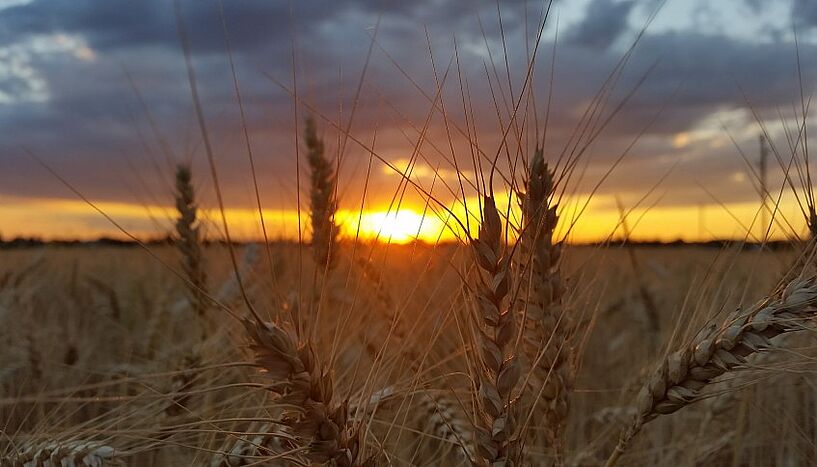
Fig. 1: Wheat field. C: Weckwerth
Focus on the interaction between the microbiome and plants
Nitrogen fertilizers used in agriculture contribute significantly to global warming. A new breeding concept, specifically for wheat, could help reduce nitrogen fertilization. This holobiont principle places the complex interactions between plants and soil microbiomes at the center of plant breeding. In combination with machine learning, this could lead to the use of new wheat varieties, as well as other crops, that are more resilient to climate change and contribute to soil health. Two recent studies led by Wolfram Weckwerth from the University of Vienna have been published in the journals Plant Biotechnology and Trends in Plant Science.
To increase the supply of food and feed, intensified agriculture has increasingly relied on nitrogen (N) fertilizers. However, more than half of the nitrogen applied to croplands annually ends up lost to air and water. Such losses lead to serious issues, including air and water pollution, soil acidification, climate change, stratospheric ozone depletion, and biodiversity loss. Consequently, reducing nitrogen loss from croplands could enhance economic returns by lowering fertilizer requirements, improve human health and ecosystem services, and contribute to mitigating climate change.
The holobiont concept: considering plants and microbes as a unit
Wolfram Weckwerth emphasizes that improving crop resilience and yield sustainably should not focus solely on plants but also on the microbiome surrounding their roots and leaves. Soil microbiomes also offer opportunities for enhancing soil fertility and reducing reliance on synthetic fertilizers. He notes: "Plant evolution is largely driven by plant-microbe interactions, yet the ecology of the plant holobiont is not well understood at a molecular level. However, these relationships hold enormous benefits for sustainable agriculture. Therefore, it is crucial to identify plant varieties that produce natural nitrification inhibitors, also known as biological nitrification inhibitors (BNIs) which are exudates by the roots in the soil".
Wheat as a natural way to slow down nitrogen loss
In a recent study, the international team investigated the potential of various wheat cultivars to produce BNIs that help control soil nitrification processes. They found a pronounced natural variation of BNI activity in different elite wheat lines.
"Our analysis of root exudates, complicated compounds released from the root system, shows substantial variation between the wheat cultivars", explains Arindam Ghatak, first author of the study. "These exudates promote or inhibit specific microbiome compositions and allow the selection of strains with particularly high BNI activity." By cultivating these BNI-active lines, farmers could significantly reduce the need for nitrogen fertilizers in the future. This is a significant step to mitigate the disruption of the global nitrogen cycle caused by the overuse of anthropogenic fertilizer.
Data-driven plant breeding for a sustainable future
To effectively utilize this nature-based solution, an international team of scientists around Wolfram Weckwerth from the Molecular Systems Biology (MOSYS) Lab and the Archaea Biology and Ecogenomics Lab at the University of Vienna has developed a novel breeding concept. Supported by partner institutions in Greece, Australia, India, Japan, Canada, the US, and Mexico the team places the holobiont concept at the center of modern plant breeding, focusing on the complex interactions between plants and soil microbiomes. Through an innovative data-driven approach, plant genetics, microbiome studies, and PANOMICS are integrated to generate high-throughput data.
"In combination with machine learning algorithms, this opens up a promising breeding platform to develop new crop varieties with high BNI potential, greater resilience to climate change, and improved soil health", explains Weckwerth. The holobiont concept thus marks a paradigm shift: it combines ecology, systems biology and breeding technology while highlighting the interconnectedness of ecosystems, and opens up new pathways toward resource-efficient and climate-resilient agriculture.
Original publications:
Arindam Ghatak1,2#, Alexandros E. Kanellopoulos3#, Cristina López-Hidalgo1#, Andrea Malits4#, Yuhang Meng1#, Florian Schindler1,#, Shuang Zhang1, Jiahang Li1, Steffen Waldherr1, Hugo Ribeiro3, Melina Kerou4, Logan H. Hodgskiss4, Maximilian Dreer4, Reyazul Rouf Mir5, Sandeep Sharma6, Gert Bachmann1, Dimitrios G. Karpouzas3, Christa Schleper4*, Evangelia S. Papadopoulou7*, Palak Chaturvedi1*, Wolfram Weckwerth1,2*: Natural variation of the wheat root exudate metabolome and its influence on biological nitrification inhibition activity. In Plant Biotechnology Journal, 2025.
DOI: 10.1111/pbi.70248
Wolfram Weckwerth; Palak Chaturvedi; Arindam Ghatak; Melina Kerou; Vanika Garg; Abhishek Bohra; Guntur V. Subbarao; Lisa Stein; Christa Schleper; Rajeev K. Varshney; Sieglinde Snapp: Natural variation of the holobiont for sustainable agroecosystems. In Trends in Plant Science, 2025.
DOI: 10.1016/j.tplants.2025.05.006
Figures:
Fig. 1: Wheat field. C: Weckwerth
Fig. 2: Schematic representation of inorganic nitrogen cycling in soil and the role of BNIs from plant root exudates in curbing the nitrification process. C: Ghatak/Weckwerth
Fig. 3: Complex interaction network of root exudate metabolites and BNI activity in different wheat genotype. C: Ghatak/Weckwerth
Fig. 4: The international consortium led by the University of Vienna for sustainable wheat breeding. C: Ghatak/Weckwerth






